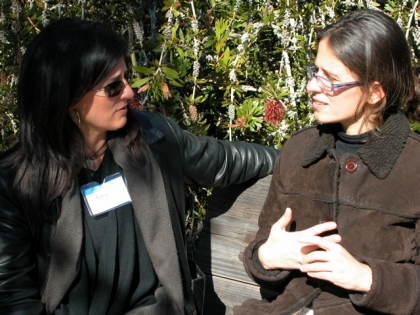Inês explains her thesis work to Terry during their first meeting
Part 1: The genesis of Sustainable Minds – The conception of ‘learning surrogate LCA’ | Ines Sousa
Early in 2007, I started a company called Clean Culture, a customer experience research and strategy consultancy focused on cleantech and sustainable business trends and their impact on culture, the economy and the planet.
In March of that year, as Ines states in her blog, my great friend Lauralee introduced us. You know the expression ‘things happen in threes’? This is a classic example. In the months prior to our meeting, two things had happened that, for me, proved to be seminal:
- In October, 2006, I read a blog post written by another great friend, Joel Makower, entitled ”Where Are All the Good, Green Products?” In it he throws down the gauntlet demanding “So, what would it take to reach the proverbial tipping point — that virtuous cycle in which large, mainstream companies trip over one another trying to "out-green" the competition, offering a dizzying array of environmentally better products, available where most people live and shop?”
He goes on to posit: “Should we even look to big companies? Perhaps the mass-marketing of greener products will come from smaller, niche firms, some destined to become acquired by the behemoths, most left to find their comfortable, profitable markets. Or perhaps it will be a whole new breed of ambitious entrepreneurs and venture capitalists fueling the green world's version of the high-flying dot-com success stories. Or, ideally, all of the above.”
- In November, 2006, while attending the U.S. Green Building Council’s national GreenBuild conference, Autodesk announced its partnership with the USGBC to integrate LEED into their product, Revit® Architecture. I thought it was brilliant to integrate new knowledge with the software tools professionals are already using.
So when Inês told me about her thesis work, it was compelling, logical – and the third thing. It all came together and I instantly had a lot more insight into why there weren’t more good green products, and that maybe there was something that could be done about it! I thought it would make for an interesting research project for Clean Culture to find out if there was now a market for a software product like Inês had described. There was already a lot happening in green building, but not so much in green products.
Over the next two months, Inês and I spoke and met with a number of design consultancies and manufacturers and learned that there was in fact a growing need, which was being driven by a number of environmental and business challenges. The big ‘aha’ from this research was learning that while the will to make greener products is there, the know-how is not. We know that companies measure what matters, and what matters gets measured. We also know that if they can measure early in the concept design phase, they can make better decisions and ultimately, make better, greener products – from the start.
So what’s it going to take to offer a dizzying array of environmentally better products? It’s going to take a lot of awareness, education and new design and engineering software tools that enable companies to learn how to act on making real change. We’re just at the beginning.
Inês and I started Sustainable Minds to help drive this change, and we hope you will be part of the solution too.
Read the next installment: Part 3: The genesis of Sustainable Minds - How we met Philip White and Okala
Check out Terry's talk at Xerox PARC on Sustainable Product Design.
Photo: Lauralee Alben

